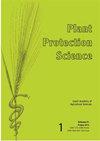Management of Fall Army Worm of Maize, Spodoptera frugiperda, with Green Synthesis Silver Nanoparticles
IF 1.7
4区 农林科学
Q2 AGRONOMY
引用次数: 0
Abstract
The fall armyworm (FAW), Spodoptera frugiperda is a polyphagous and economically important insect pest originated from tropical and sub-tropical parts of America. Being a strong flier, climatic adaptation and large host range makes it a serious threat to food security. It is responsible for high economic losses in many cash crops, vegetables and cereals. The overreliance and overuse of pesticides for the management of FAW posed many problems including insecticide resistance, resurgence of insect pests, biotype development and environmental hazards. To combat these problems, the most important alternative is the use of green synthesis nanoparticles and biocontrol agents which have been proven as eco-friendly technology for pest control. The current study was, therefore, planned to evaluate the toxicity of different plant based synthetic nanoparticles and biocontrol agent (Trichogramma spp.) against fall armyworm. Silver nanoparticles of neem resulted in the highest (83%) and the lowest (40%) mortality of 2nd instar larvae of FAW. However, the highest mortality due to silver nanoparticles of tobacco, onion, mint, ginger and datura was observed as 86%, 63%, 76%, 63% and 73% while the lowest mortality was 30%, 33%, 30%, 23% and 16% respectively. In view of the current findings nanoparticles of datura and neem could be recommended as potential bio-based chemicals for the control of S. frugiperda.绿色合成纳米银对玉米秋虫的治理
秋粘虫(Spodoptera frugiperda)是一种多食性害虫,原产于美洲热带和亚热带地区,具有重要的经济价值。由于其飞行能力强,气候适应性强,寄主范围广,对粮食安全构成严重威胁。它对许多经济作物、蔬菜和谷物造成了巨大的经济损失。由于对农药的过度依赖和过度使用,造成了农药抗药性、害虫死灰复燃、生物型发育和环境危害等诸多问题。为了解决这些问题,最重要的替代方案是使用绿色合成纳米颗粒和生物防治剂,这些已被证明是防治害虫的环保技术。因此,本研究计划评估不同植物合成纳米颗粒和生物防治剂(赤眼蜂spp.)对秋粘虫的毒性。印楝银纳米颗粒对2龄幼虫的死亡率最高(83%),最低(40%)。烟草、洋葱、薄荷、生姜和曼陀罗对纳米银颗粒的最高致死率分别为86%、63%、76%、63%和73%,最低致死率分别为30%、33%、30%、23%和16%。鉴于目前的研究结果,曼陀罗纳米颗粒和楝树纳米颗粒可以作为潜在的生物基化学药剂用于防治果蚜。
本文章由计算机程序翻译,如有差异,请以英文原文为准。
求助全文
约1分钟内获得全文
求助全文
来源期刊

Plant protection science
Agronomy-PLANT SCIENCES
CiteScore
2.90
自引率
7.70%
发文量
30
审稿时长
12 weeks
期刊介绍:
Original papers, short communications, critical reviews, personal news, and book reviews covering all areas of diseases and pests of plants, weeds and plant protection. Papers are published in English.
 求助内容:
求助内容: 应助结果提醒方式:
应助结果提醒方式:


